Microwave Recycling: How to Dispose of Your Microwave Oven?
Written by : Nikola Gemeš | Last Updated: March 28, 2024
Contents
ToggleE-waste is currently the fastest growing type of municipal waste in America. But how to get rid of a microwave? Is there an alternative to microwave recycling?
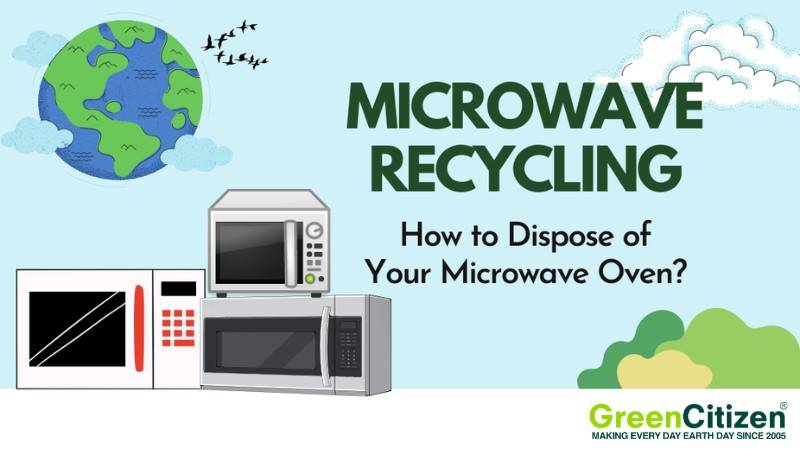
Although e-waste represents only 2% of America’s trash, it makes up 70% of the overall toxic waste that enters our landfills. Now, think about this – only a slim 15% of our appliances ever get recycled.
Every year, we're tossing away close to 6.9 million tons of metals, glass, and valuable materials. By 2030, we'll produce 81.6 million tons of e-waste globally.
This needs to change fast!
Let’s start with recycling microwaves — almost every household has at least one, and we buy new models every five years. Unfortunately, many don’t know that you can recycle microwaves quite easily.
It's high time we got serious about finding and supporting efficient microwave recycling solutions.
So, before you think about tossing your old microwave, follow the recycling guidelines in this blog.
How to Dispose of a Microwave Oven?
Now, we’ll go over the six most popular ways on how to dispose of a microwave oven.
1. Find the Nearest E-Waste Recycling Centers
This is by far the best and the most eco-friendly way of disposing of your old microwave.
There is no law against microwave recycling anywhere in the world. Through recycling, you’re not only helping save all reusable parts, but also helping the environment.
So can I just shove it down the recycling bin like paper, glass, or plastics?
Of course NOT!
A microwave is a complex device that contains different recyclable materials. E-waste recycling centers employ trained professionals who will take your microwave apart safely, sorting out the useful parts. So, you don't have to worry about taking apart the device yourself.
So where can you recycle a microwave?
If you’re having trouble finding a microwave recycling depot or store, check out our amazing GreenDirectory.
It’s really easy to use:
How to Find the nearest E-Waste Recycler Using Green Directory?
Select the type of e-waste
Go to Green Directory and type in "microwaves" in the textbox below the "SEARCH FOR" button. Select the suggested "microwaves" option.
Choose your location or ZIP Code
Enter your ZIP code. If you're unsure of your ZIP code, check the "Use Current Location" option. Our tool will automatically grab it
select an e-waste recycler
Upon pressing the "SEARCH" button, a list of recyclers will appear within 10 mile radius of your location. You can also change the radius.
Recycling centers generally try to repair and sell or donate items that are worth repairing. In other cases, they may use your old microwave for parts or salvageable materials.
If there are no microwave recycling facilities near you, there’s still a way for you to recycle.
Many recycling centers, including GreenCitizen, accept mail-ins. Send us your microwave and we’ll recycle it for a small fee. This is a great option if you don’t drive or otherwise can’t make it to the nearest drop-off site.
Any of these scenarios is much better than sending your appliance to the landfill.
Even worse, you may actually get a fine for dumping a microwave, but we’ll get there soon.
2. Use the Municipal Waste Center or Your Local Trash Pick-up Company
The easiest way to get rid of the old microwave is to leave it to the waste collectors alongside your household trash. After all, a microwave is not hazardous waste, right?
But now listen to this!
Different states and municipalities treat electronic waste and small appliances differently. So there are good chances that leaving your microwave at the curbside is illegal where you live.
In California, for example, the only legal way to dispose of it is to go through a microwave recycling facility or retailer take-back program.
But let’s just stop here for a second.
Even if there is no law against dumping your microwave, it doesn’t mean it is the right thing to do.
I mean, isn’t there enough trash on this beautiful planet already?
3. Drop it off at the Local Garbage Center or Landfill
If you still decide to do it the Homer Simpson way and give your microwave “back to the Earth”, you can as well drop it off yourself.
Call your local landfill or garbage center and ask how to dispose of the microwave legally. They usually have special dumpsters or bins for electronics and small appliances. This way, you’ll probably avoid paying a fee for the pickup service.
Even so, I strongly advise against sending your microwave to the landfill.
Hazardous waste or not, your microwave will take a thousand years to decompose. And there’s definitely a better way to dispose of it without harming the environment.
If You live in the San Francisco Bay Area, bring your microwave to GreenCitizen Drive-through Recycling Drop-off center in Burlingame.
Not only will you help the environment and support a local business, but also help this model of e-waste recycling spread to other metropolitan areas.
4. Ask About In-Store Collection Programs
Some big-box stores have their own take-back and recycling programs for electronics and appliances.
Keep in mind that every store has its own microwave recycling policy, so it’s best you call and ask about old microwave disposal options. Staples, for example, accepts only office electronics.
Ok, but does Best Buy recycle microwaves?
Yes, but only as a one-to-one replacement — buy one, and they’ll recycle one.
Lowes and Sears will also have a microwave recycling program, but you still have to buy a new one.
Many independent appliance stores also have microwave recycling programs, and some of them may even offer store credits or other incentives for buying a new product.
5. Check out Manufacturers’ Microwave Recycling Programs
Major appliance manufacturers like Bosch, GE, and LG have recycling programs for their brands.
Visit your manufacturer’s website and enter your zip code, and it’ll show you the nearest drop-off location. For further information, you could check out their e-waste recycling program.
Apart from drop-off recycling, LG also offers mail-back microwave recycling throughout the US at no cost. Download and print the mail-back label from their website and send your microwave back to the factory.
Sure, this is great news for LG-owners, but what about the rest of us?
If your microwave brand doesn’t have a mail-back program, there’s no reason to worry.
You can use GreenCitizen Mail-in Electronic Recycling which also accepts small kitchen appliances including microwaves. This no-contact microwave recycling method has been especially popular during the COVID-19 pandemic.
I myself couldn’t find a microwave disposal near me, so I mailed it in.
6. Donate Your Old Microwave
If your microwave still works, don’t throw it away. Give it to a student heading off to college or donate it to a local school, church, or nonprofit organization.
Thrift stores like Goodwill give a part of their proceedings to charities, and will happily accept your working microwave. You can also give it away on Freecycle or list it for free on Craigslist.
I personally prefer local-based Facebook giveaway groups — there’s zero hassle and zero paperwork.
Can You Throw a Microwave in the Trash?
This very much depends on where you live, as different states and municipalities have different laws of what can go in the dumpster.
The best place to check this is your city’s website. Or even better, call the garbage company directly.
Your community may also have bulk pick-up days. This is when you can leave bulky items on the curbside with the rest of your trash without getting a fine. However, many places consider microwaves as e-waste and have special rules for old microwave disposal.
But once again, if you’re already taking it somewhere, skip the landfill and bring it to a microwave recycling center.
Although your microwave may not contain hazardous materials like lead or mercury, it’s much better for the environment if you have it scrapped for parts and materials.
Is It Safe to Take Apart a Microwave?
No, it’s definitely not safe to take apart a microwave — for several reasons.
First of all, your microwave is a high voltage appliance and you should never try to take it apart when plugged in. The high voltage transformer can produce up to 4200 volts on its secondary coil, and there is also a big high-voltage capacitor. This bad boy can deliver a deadly discharge shock even months after you unplug the oven.
Finally, there’s the magnetron that produces microwaves that heat your food. It’s a special type of vacuum tube with powerful magnets.
Nothing dangerous about those, but to get to them you need to remove a large ceramic insulator. This insulator is made of a special ceramic called beryllium oxide which is carcinogenic when inhaled.
I wouldn’t mess with that!
Is It Safe to Fix a Broken Microwave?
Warning: Only try to fix a broken microwave if you’re a trained electrician.
The microwave may have revolutionized the way we go about food preparation, but is also one of the most difficult and dangerous appliances to repair at home.
First of all, microwaves come as compact units and everything is packed tight. Because of this, if you need to repair a microwave, you’ll probably need to take it apart completely.
Your biggest concern should be the high voltage capacitor. It can hold a powerful electrical charge even months after use. So, whatever you do, your first action should be to safely discharge the microwave capacitor.
You can, on the other hand, hire a professional to fix your microwave for you. This especially makes sense if the damage is cosmetic and non-electrical. A faulty door hinge or broken plate spinning assembly is relatively easy to repair and shouldn't cost a lot.
But what if the oven needs a new magnetron or control panel?
In this case, it makes more sense to send it to a microwave recycling facility than to pay for the repair. After all, replacement parts for many cheaper microwave brands often cost more than you’d pay for the whole new thing.
FAQ
Do Old Microwaves Leak Radiation?
Yes, old microwaves can leak radiation if their door seals break or get damaged in any other way.
How Many Years Does A Microwave Last?
An average microwave lasts for about 7 years before you see any signs of wear or drop in performance.
Where Can I Get A Broken Microwave?
You can get a broken microwave at thrift stores or sites like Freecycle and Craigslist
Are There Any Microwave Parts Worth Selling?
Yes, the magnetron, the transformer, and the rotating glass tray are definitely worth selling, but don’t expect to get rich.
What Stores Accept Old Microwaves?
Stores that accept old microwaves include Lowes, Sears, and General Electric, but make sure to ask at independent appliance stores, as well.
Conclusion
Microwave recycling is the cleanest, greenest, and the most efficient way to dispose of your old or broken microwave. Recycling saves your microwave from going to the landfill and also makes sure some of its components are used for a new product.
But then you may ask, “Where to recycle a microwave near me?” It’s really simple — use our GreenDirectory to find nearest recycling centers and collection sites.
If you’re still not sure how to dispose of a microwave in a responsible way, feel free to ask our experts.
We’ll come up with a solution that works best for you.
Nikola Gemeš
Nikola, an electrical engineer, simplifies intricate sustainability subjects for his audience. A staunch environmental conservationist, he embodies his beliefs daily through recycling and cultivating his own food.
| Thank you for Signing Up |


Category: Circular Economy, Environment, Green Blog, Home Environment, Most Popular Tags: how to dispose of your microwave, microwave disposal, microwave recycling
9 Comments on “Microwave Recycling: How to Dispose of Your Microwave Oven?”
Services(United States)
For Businesses
Copyright © 2024 · All Rights Reserved · GreenCitizen

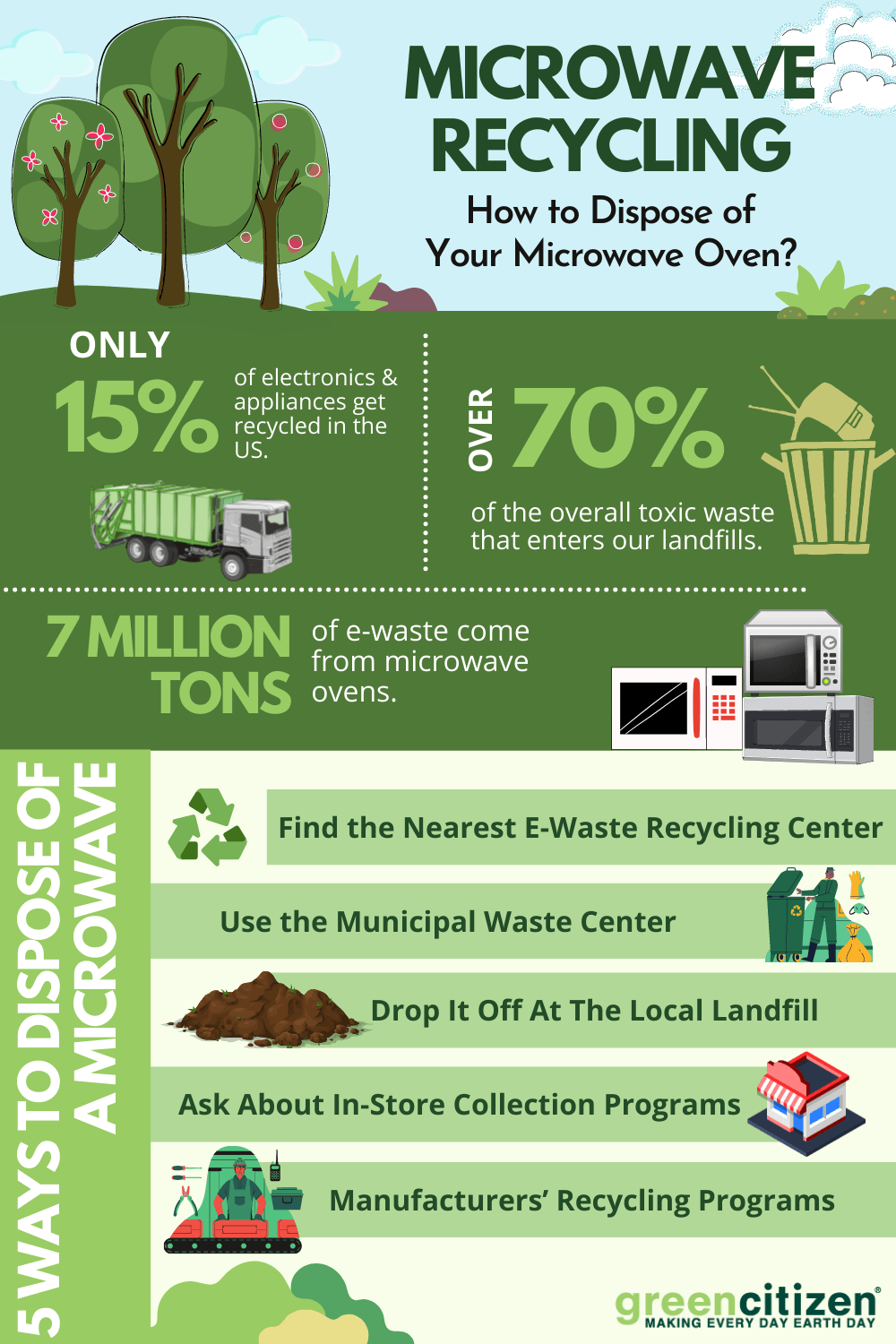
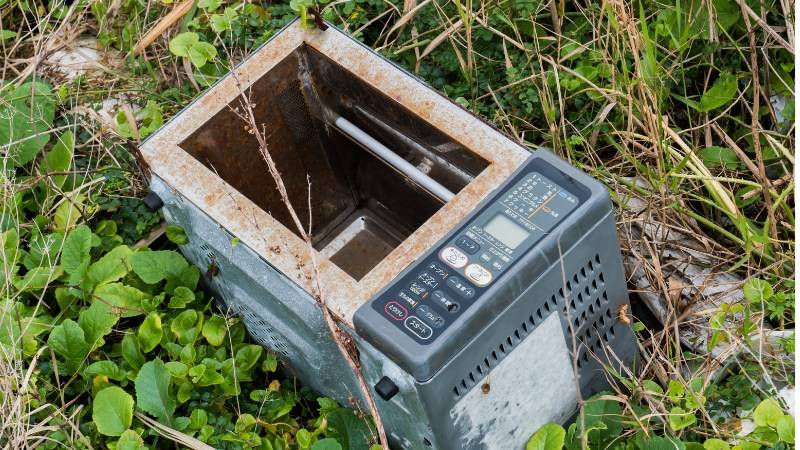
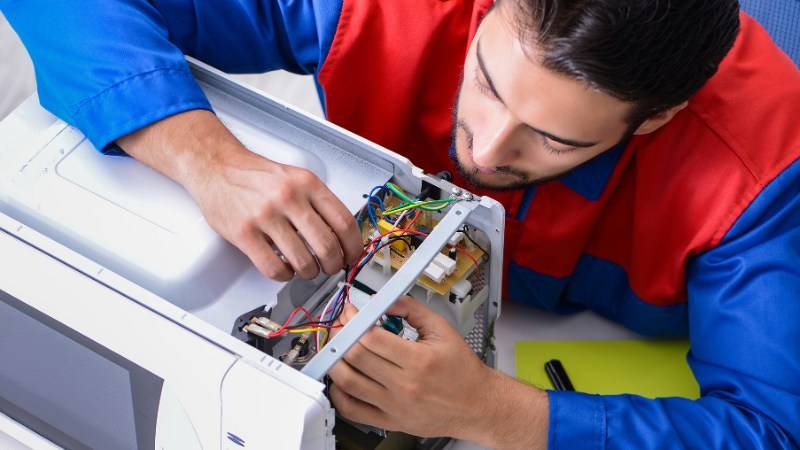
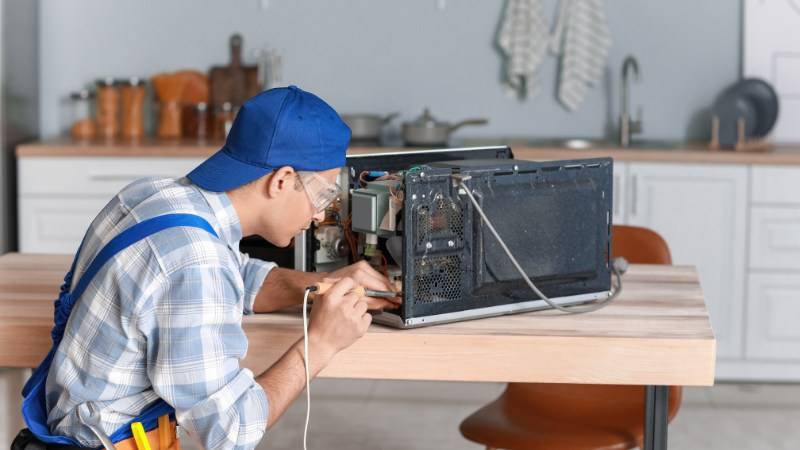







You’re not telling me where I can get rid of the magnetron I already have two of them and I need to get rid of them right now but I still want the magnets
All this sounds good BUT: For those of us without vehicles or friends willing to recycle our microwaves or take us to a recycling dropoff, these are inevitably going in the trash. GreenCitizen might want to consider developing a program of volunteers who will pick up and drop off, or take us to a recycling destination. Presumably there are lots of Green Citizens out there who would be interested in doing just that.
Microwaves often are classified as electronic waste (e-waste), and, as such, cannot simply be placed out with the trash or tossed into a dumpster. Consulting local regulations will help you identify whether there are any specific directions listed for microwave disposal.
Pingback: 6 Steps To Install Over-The-Range Microwave Without A Cabinet
Really a wonderful artical.I had loved been reading this .Thank you so much for this informative artical.Its very much helful while recycling a microwave because many people are not aware of this.
Pingback: The ABCs of Glass Recycling: Can You Recycle Glass?
Microwaves contain small amounts of mercury, which can be accidentally released when the recycling process is not handled properly.
Thank you for your comment.
It’s true that older microwaves contained mercury but most new models don’t have mercury in them. Also, believe that it’s very important to choose a qualified e-waste recycler to recycle your microwave oven.
Where in Abilene Texas can I recycle a microwave